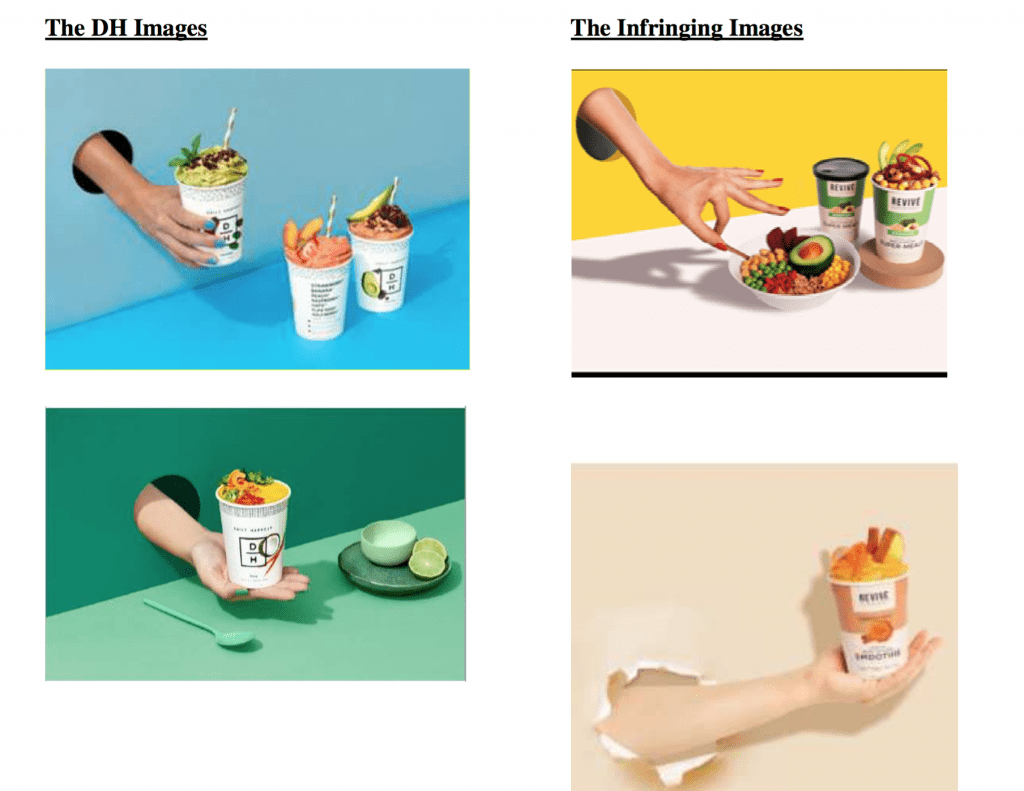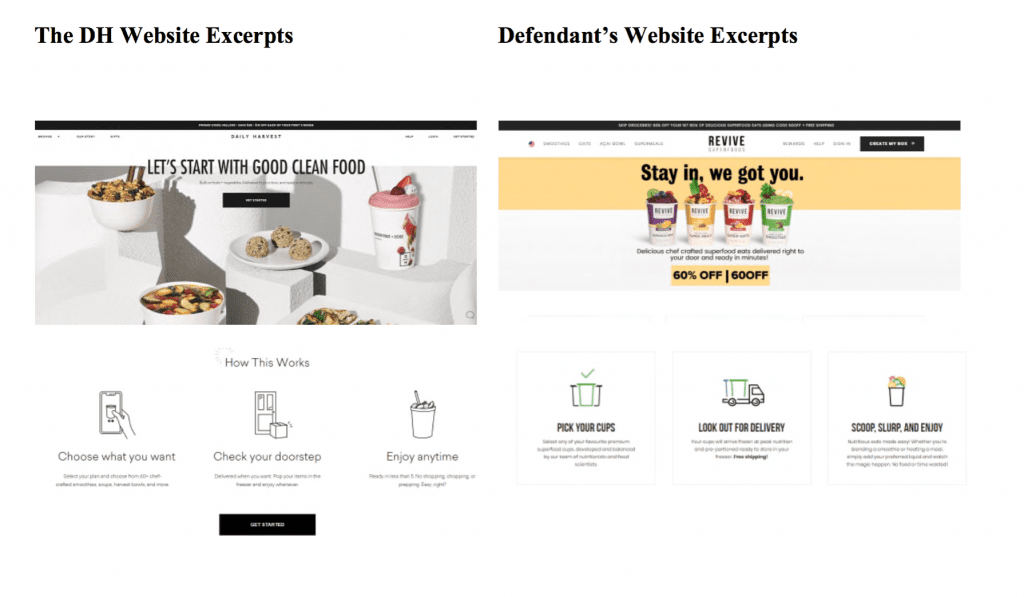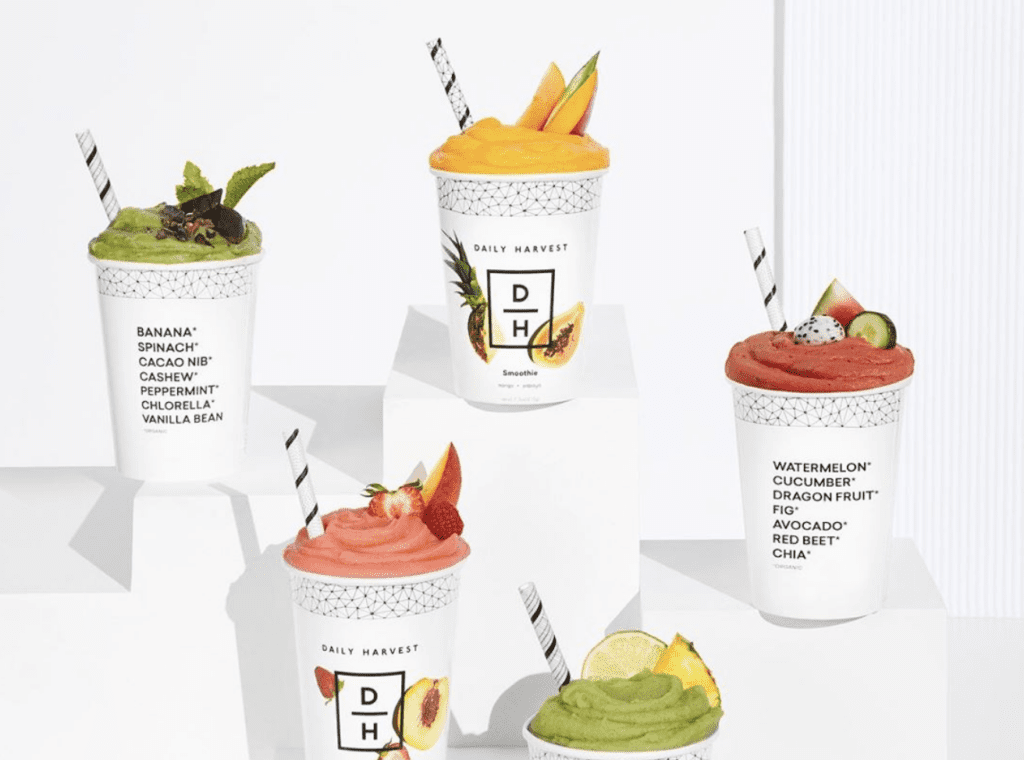Seven months after first filing suit against fellow frozen food company Revive, citing claims of trademark and trade dress infringement, and unfair competition, among others, Daily Harvest has amended its complaint to include copyright infringement allegations in connection with Revive’s alleged launch of a “competing product line in Canada,” complete with “shameless copying of wholesale portions of Daily Harvest’s trade dress, including its product packaging, website and other key branding elements.”
According to its amended complaint, which was filed in a New York federal court on November 20, Daily Harvest – a buzzy and “rapidly growing” direct-to-consumer startup that aims to bring “healthy, easy-to-make foods” directly to the consumer’s home – asserts that Revive has engaged in a scheme to “free-ride [on its] coattails and trade off of [its] reputation.” Mirroring the claims in its April 2020 complaint, Daily Harvest asserts that in a quest to “receive all the benefits of Daily Harvest’s investments [in its branding and digital presence] without incurring any of the costs” as it expands in the U.S. market, Toronto-based Revive has adopted “an identical and confusingly similar website design, content, product packaging, [and] images.”
Specifically, Daily Harvest alleges that it has consistently used “unique and inherently distinctive” packaging – namely, “a white background, featuring the two letters DH, displayed in black in the center of the packaging inside a square with a line placed in between the letters D and H, with a black and white geometric-patterned band along the upper rim of the cups, featuring photographs of the product ingredients on the front of the cups, with the ingredients listed on the back of the package in large black font” – to “distinguish [its products] from similar goods offered by others,” thereby, giving rise to trade dress rights, which Revive has allegedly copied.
Beyond its packaging, 5-year old Daily Harvest argues that it also maintains trade dress rights in the “look and feel” of its website – from the layout and some of the language to the “user shopping experience and interface design.”
Adding to the claims it set out in April, Daily Harvest asserts in its newly-filed amended complaint that Revive is also engaging in copyright infringement, as it has allegedly hijacked “product packaging and certain original photographs,” as well as “the unique and innovative design of [Daily Harvest’s] website.”
Taken together, Daily Harvest contends that Revive’s conduct – which “constitutes not only copyright infringement and trade dress infringement, but unfair competition under both federal and state law” – is intended to “confuse consumers to believe that [it] and/or [its] goods and services emanate from or are otherwise approved or sponsored by Daily Harvest, and it is an attempt by [Revive] to reduce its costs of entry into the market by freeriding off of Daily Harvest’s brand image and the goodwill developed by Daily Harvest.”

“Meritless” Trade Dress Claims?
Potentially even more interesting that Daily Harvest’s latest allegations is a joint letter that parties filed with the court back in July, in which Daily Harvest summarized its case, and Revive set out some preliminary arguments of its own, namely, shooting down Daily Harvest’s trade dress claims – and its case as a whole – as devoid of merit.
Setting the stage in that letter, counsel for Revive asserted that despite what Daily Harvest has argued, “This not a case about intellectual property infringement, [and instead], this action is a bald effort by Daily Harvest to stifle fair competition by invoking invalid purported intellectual property rights to protect an unprotectable business idea.”
According to Revive, Daily Harvest has sought to protect its DTC frozen food subscription business model – as opposed to protectable branding-centric assets – by setting out trade dress infringement claims that fail both in regards to the design of its website and its product packaging. To be exact, Revive argues that because the trade dress that Daily Harvest’s asserts in the appearance of its website and its packaging is not registered, the company “bears a ‘heavy burden to demonstrate it is entitled to protection,’” and in fact, the company fails to meet that burden for three reasons, per Revive.
Primarily, Revive asserts that Daily Harvest’s alleged website trade dress is not distinctive, “meaning that the design of the website itself is not an indicator of source.” Aside from the Daily Harvest name, Revive argues that Daily Harvest’s “website is a compilation of common ornamental and functional features that are neither inherently distinctive nor have they acquired distinctiveness.”
In case that is not enough, Revive claims that Daily Harvest’s alleged website trade dress is invalid because “the vast majority of its listed elements are functional and, even when combined with ornamental elements, cannot serve as part of its protectable trade dress.”
Examples of the functional elements that Daily Harvest claims as part of its protectable trade dress? “Crisp white backgrounds,” “modern and sleek black font,” brand names “centered at the top of a homepage,” “sleek black banners,” “colorful photograph[s] of a line up [of the products sold on the website] with garnishes,” “categories of products displayed horizontally in black font,” displaying ingredients in a “transparent cup” so they can be seen, “photograph[s] from a head-on view perspective as if ready for the consumer to enjoy,” “subpages featuring rows and columns of product images” and “textual description[s] of the product, with a summary of the benefits delivered.”
These elements “are ubiquitous on websites and designed to make it easier to read the contents of the website,” Revive argues, and thus, are not protectable.
Finally, Revive contends that “even if Daily Harvest could prove a protectable trade dress in its website,” it cannot show that consumers visiting Revive’s website are likely to confuse its products with Daily Harvest’s. Pointing to a 2004 decision from U.S. District Court for the Southern District of New York in the Louis Vuitton Malletier v. Dooney & Bourke case, Revive asserts that “the prominent use of … brand names throughout [the respective companies’] websites is itself powerful evidence that confusion is unlikely.”
Revive notes that its site “significantly, contains the name REVIVE SUPERFOODS on every single page,” and that Daily Harvest, in order “to clearly identify its source … uses the name DAILY HARVEST prominently all over” its site, as well.

And still yet, in terms of Daily Harvest’s trade dress claims for its product packaging, those fail for the same reasons, per Revive. In addition to noting that “another court in the Southern District” determined in 2018 “in a previous litigation that Daily Harvest filed against yet another competitor” that Daily Harvest’s “claims as to secondary meaning [in the package design] . . . are conclusory at best,” Revive argues that Daily Harvest’s description of its alleged packaging trade dress leaves out the very things that consumers likely use to tie the products to Daily Harvest: its word mark and logo.
Revive argues that Daily Harvest “deceptively leaves out the elements that are the mostly likely to help consumers identify the brand – namely, the repeated references to DAILY HARVEST on the cups and the prominent D/H logo.” Revive says that it “has never used those elements; to the contrary, its colorful packaging prominently features the REVIVE SUPERFOODS trademark.”
Revive followed up on the July letter to with a subsequent letter on August 7, in which it alerted the court to a survey that it had commissioned “to assess the extent to which the Revive website, which is at the center of [Daily Harvest’s] trade dress infringement challenge, was likely to cause confusion.” According to Revive, its expert conducted a consumer perception survey of more than 200 individuals “likely to purchase the parties’ products in the next three months,” and found that “less than one percent of the respondents indicated that they associated the Revive website with Daily Harvest,” making the notion of potential confusion between the two companies’ sites virtually “inconceivable.”
As for the copyright claims, Revive asserted in July that while it had not seen Daily Harvest’s claims yet, they were likely to fall short, as well. Speaking specifically to Daily Harvest’s claims in connection with photos that feature “arms or hands popping out of walls,” Revive stated that “although both companies have posted their own versions of this concept … they are similar once again only with respect to the idea and concept. The idea of photos of arms or hands popping out of the wall is not original, and the expression is not substantially similar: The poses are different, the products depicted are different, and the backgrounds are different. Indeed, other brands have utilized similar concepts.”
Revive’s points in the July letter generally raise some interesting questions about the protectability of website designs (in the DTC space and beyond), including “the user shopping experience and design interface,” particularly as websites come to look more and more alike over time. This is something that Sam Goree, a PhD student in Informatics at Indiana University, and his colleagues recently determined in connection with a study of the websites of the top U.S. businesses by market capitalization, as well as those on Alexa’s list of the 500 most trafficked sites, among others.
They found that most websites are essentially beginning to look the same for a variety of reasons (many of which are inherently practical in nature). This trend is presumably even more obvious when it comes to companies operating within the same space, such as DTC subscription companies, and given that design form – from an e-commerce website’s layout/user flow to the specific language used by a brand – is in many cases defined, to some extent at least, by the function of the business model, and the constraints of digital operations more generally.
Still yet, as Modern Retail noted early this year in reference to the increasingly crowded DTC space, where many buzzy young brands rather notoriously share similar aesthetics, it is simply “getting harder for startups to design a website that doesn’t rely on at least some of the same design principles as competitors.”
*The case is Daily Harvest, Inc., and Rachel Drori, v. Revive Organics, Inc., 1:20-cv-03087 (SDNY).














